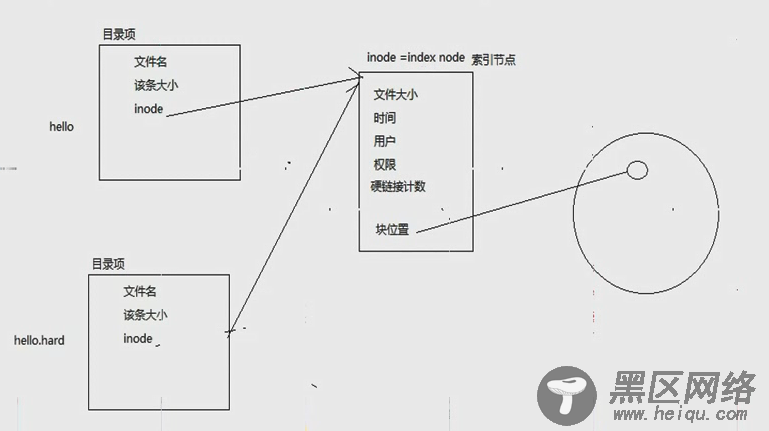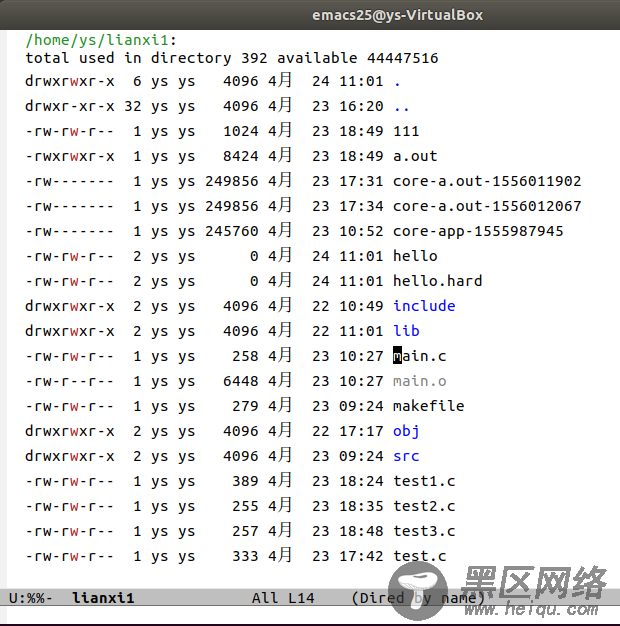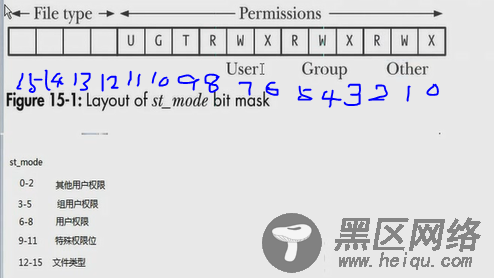stat函数和stat命令
Linux文件里的【inode = index node】解释:要理解inode必须了解磁盘和【目录项】,inode实际是连接【目录项】和磁盘的中间物质。
图里的大圈代表硬件的磁盘,里面的小圈代表某个文件存储在磁盘上了。
【inode = index node】的node(承载node信息的结构体是:stat,stat的定义在后面 )里面有:
文件大小
文件的最后修改时间
文件的所属用户
文件的权限
硬链接计数(ls -l 显示出来的数字)
块位置:指定文件存储在磁盘的具体位置。
下图中的hello是个普通文件,hello.hard是hello的硬链接
文件夹里放的就是每个文件的【目录项】如下图,【目录项】里有:
文件名
该目录项的大小
文件的类型
inode

如何查看文件的【inode】呢?使用【-i】选项
ls -li 文件名执行结果:
ys@ys-VirtualBox:~/lianxi1$ ls -li hello hello.hard 3801352 -rw-rw-r-- 2 ys ys 0 4月 24 11:01 hello 3801352 -rw-rw-r-- 2 ys ys 0 4月 24 11:01 hello.hard发现hello和hello.hard的inode(3801352)是相同的,也就说明了,只在磁盘上存了一份。
如何查看目录项呢?用emacs或者vim打开目录(lianxi1),截图如下。但是看不到文件的【inode】。

1,stat函数:取得指定文件的文件属性,文件属性存储在结构体stat里。
#include <sys/types.h> #include <sys/stat.h> #include <unistd.h> int stat(const char *pathname, struct stat *statbuf); int fstat(int fd, struct stat *statbuf); int lstat(const char *pathname, struct stat *statbuf);struct stat 结构体:
struct stat { dev_t st_dev; /* ID of device containing file */ ino_t st_ino; /* Inode number */ mode_t st_mode; /* File type and mode */ nlink_t st_nlink; /* Number of hard links */ uid_t st_uid; /* User ID of owner */ gid_t st_gid; /* Group ID of owner */ dev_t st_rdev; /* Device ID (if special file) */ off_t st_size; /* Total size, in bytes */ blksize_t st_blksize; /* Block size for filesystem I/O */ blkcnt_t st_blocks; /* Number of 512B blocks allocated */ /* Since Linux 2.6, the kernel supports nanosecond precision for the following timestamp fields. For the details before Linux 2.6, see NOTES. */ struct timespec st_atim; /* Time of last access */ struct timespec st_mtim; /* Time of last modification */ struct timespec st_ctim; /* Time of last status change */ #define st_atime st_atim.tv_sec /* Backward compatibility */ #define st_mtime st_mtim.tv_sec #define st_ctime st_ctim.tv_sec };
st_dev:设备ID,不太常用
st_ino:【inode】,【inode】是啥?不知道就看上面关于【inode】的解释
st_mode:文件的类型和权限,共16位,如下图。
0-11位控制文件的权限
12-15位控制文件的类型
0-2比特位:其他用户权限
3-5比特位:组用户权限
6-8比特位:本用户权限
9-11比特位:特殊权限
12-15比特位:文件类型(因为文件类型只有7中,所以用12-14位就够了

文件类型的宏如下(下面的数字是8进制):
S_IFSOCK 0140000 socket
S_IFLNK 0120000 symbolic link(软连接)
S_IFREG 0100000 regular file(普通文件)
S_IFBLK 0060000 block device(块设备文件)
S_IFDIR 0040000 directory(目录)
S_IFCHR 0020000 character device(字符设备文件)
S_IFIFO 0010000 FIFO(管道)
判断文件类型的函数,返回true,false S_ISREG(stat.st_mode) is it a regular file? S_ISDIR(stat.st_mode) directory? S_ISCHR(stat.st_mode) character device? S_ISBLK(stat.st_mode) block device? S_ISFIFO(m) FIFO (named pipe)? S_ISLNK(stat.st_mode) symbolic link? (Not in POSIX.1-1996.) S_ISSOCK(stat.st_mode) socket? (Not in POSIX.1-1996.)
